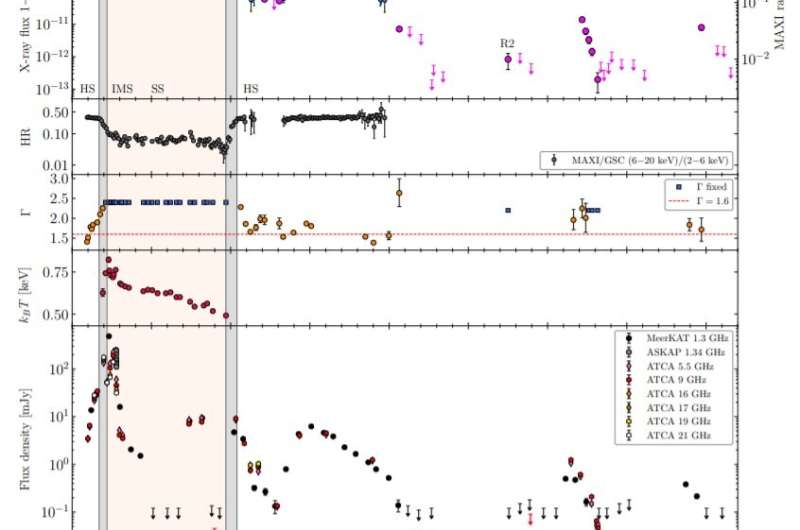March 30, 2021 report
Astronomers inspect black hole X-ray binary MAXI J1348–630

An international team of astronomers has carried out a comprehensive radio and X-ray monitoring of a black hole X-ray binary known as MAXI J1348–630. The observational campaign provided important insights into the evolution of the source's compact and transient jets. The study was presented in a paper published March 22 on arXiv.org.
Black hole X-ray binaries (BHXBs) are binary systems consisting of a black hole orbited by a stellar companion, typically a low-mass, evolved star. In BHXBs, X-rays are produced by material accreting from a secondary companion star onto a black hole primary. Such systems are usually detected in outbursts when the X-ray flux increases significantly.
MAXI J1348–630 was initially detected on January 26, 2019 as a bright X-ray transient by the Monitor of All-sky X-ray Image (MAXI) aboard the International Space Station (ISS). Further observations of this source confirmed that it is a BHXB with a black hole mass of about seven solar masses at a distance of some 7,170 light years away from the Earth.
Almost immediately after the bursting activity of MAXI J1348–630 started, a group of astronomers led by Francesco Carotenuto of the University of Paris, France, commenced a monitoring campaign of this source with the aim of shedding more light on its nature. They observed MAXI J1348–630 in the radio band with the MeerKAT telescope in south Africa and the Australia Telescope Compact Array (ATCA), and also in the X-rays using MAXI and NASA's Swift spacecraft.
"In this work, we have presented the X-ray and radio monitoring of MAXI J1348–630 during its 2019/2020, discovery outburst. With our X-ray monitoring, we have been able to follow the whole outburst," the researchers wrote in the paper.
The observations show that during the outburst MAXI J1348–630 exhibited a rather typical X-ray evolution in the first part, completing a whole cycle in the hardness-density diagram (HID), and then showcased a complex sequence of hard-state-only re-brightenings in the second part.
During the outburst, Carotenuto's team observed the rise, quenching, and re-activation of the compact jets. They also identified two single-sided discrete ejecta, launched about two months apart and traveling away from the black hole. These ejecta had proper motion at a level of some 100 mas/day—the highest proper motion measured so far for such features in BHXBs.
The astronomers found that the first ejection happened during the hard-to-soft state transition of the source, before a strong radio flare. When it comes to the second ejection, it was launched during a short excursion from the soft to the intermediate state.
According to the authors of the paper, the results suggest that MAXI J1348–630 appears to be inside a low-density cavity in the interstellar medium (ISM).
"After traveling with constant speed, the first component underwent a strong deceleration, which was covered with unprecedented detail and suggested that MAXI J1348–630 could be located inside a low-density cavity in the interstellar medium, as already proposed for XTE J1550–564 and H1743–322," the researchers concluded.
More information: The black hole transient MAXI J1348–630: evolution of the compact and transient jets during its 2019/2020 outburst, arXiv:2103.12190 [astro-ph.HE] arxiv.org/abs/2103.12190
© 2021 Science X Network



















